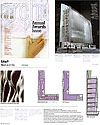 architecture
architecture
Annual Awards Issue
April 1999
Progressive Architecture Award
Project: Museum of Sex, New York City
Site: An L-shaped lot at the corner of Fifth Avenue and East 27th Street.
Program: A cultural institution for a candid presentation of the history, evolution, and significance of sex.
Solution: A space for human sexuality is enclosed in an undulated glass wall that alludes to the surface of the body. Its translucent layers are alternately fused together and pulled apart to create an institution that reveals itself thorough passages within its skin-like enclosure. The fluidity of the building fašade alludes to the 36,000-square-foot museum's curatorial intention: to present sex as a universal aspect of humanity that needs to be understood from multiple perspectives.
Client: Daniel Gluck, Alison Maddex
Architect: ShoP/Sharples, Holden, Pasquarelli, New York City - Kimberly J. Holden, Gregg A. Pasquarelli, Christopher R. Sharples, Coren D. Sharples, William W. Sharples (principals), Shigeru Kuwahara, Max Strang (project team)
Engineers: Buro Happold New York (structural); Lazlo Bodak Engineer (mechanical, electrical)
Consultant: Andreas Froech (stereolithography)
Fisher: I love the idea that so much of the appeal of sex is tactile. It's about the skin and so the whole building is about the skin and not just undulated walls.
Yazdani: I'm quite fascinated with the skin. But there are a couple of interior views of the building that reveal how this skin or the glass is constructed that concern me. Maybe the simplicity that we find in that skin may not, in the end be translated into built form. Ultimately this horizontally gridded surface fights the vertical curvature of the skin.
Machado: I wish the interiors would have also been explored more. The same operation that they've got in the front could have been carried out inside, because otherwise, the vision is of very sterile, orthogonal space. I guess the installation or gallery designer could bring to the interiors the quality of the exterior.
Tsien: That's true. I think that's very important because the interior needs to have a correlation to the exterior.
Jiricna: They don't necessarily need to express the inside on the outside. This, like most of the other projects we are judging, is in a stage where we can't actually criticize the building on the real issues, just on the concept, unfortunately.
Yazdani: It's very similar to the human body where you have a skeleton and then you have a skin.
|